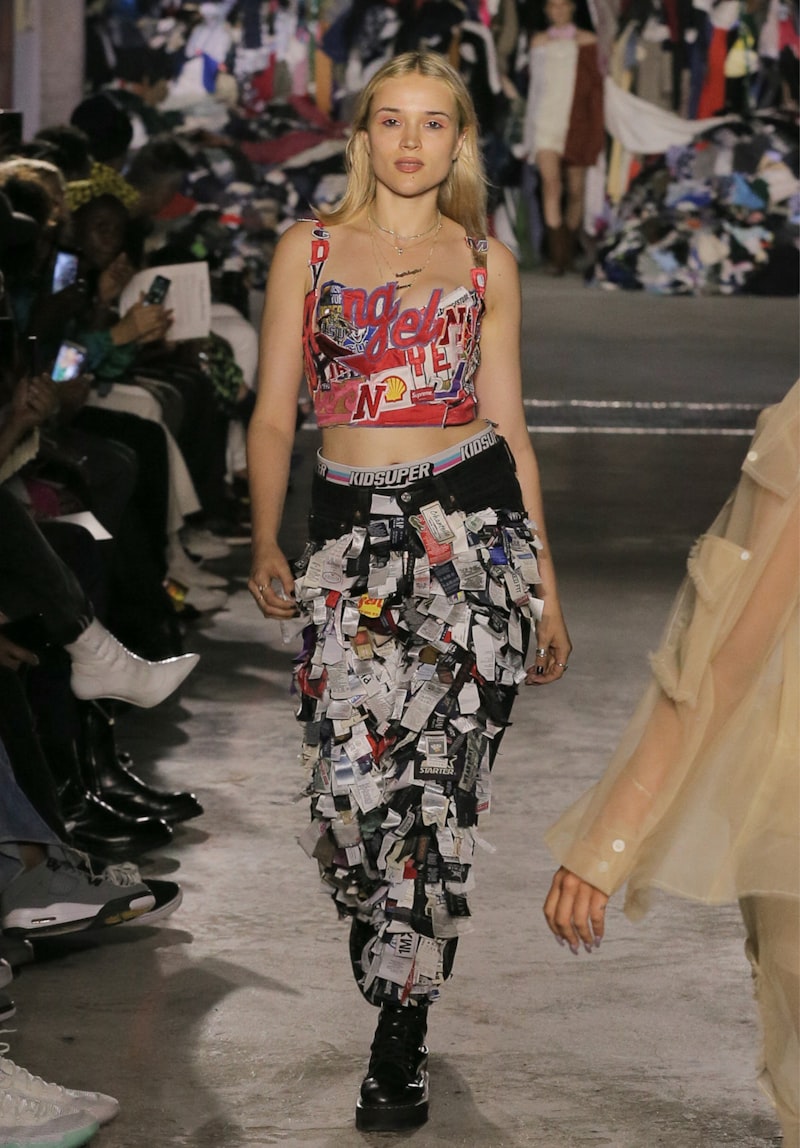In a world where trends shift like the wind, fashion designers like Giorgio Armani stand as pillars of consistency and class. Armani’s mastery lies in his ability to blend traditional craftsmanship with contemporary flair, creating garments that exude effortless chic. His tailored suits are synonymous with power and refinement, adorning celebrities and executives alike with an aura of understated luxury.
But fashion isn’t just about aesthetics; it’s about storytelling. Vivienne Westwood, the punk rock queen of couture, uses her designs to challenge conventions and provoke thought. Her creations are a rebellion against the status quo, blending high fashion with activism. Each garment becomes a statement piece, demanding attention and sparking dialogue about social issues and individuality.
Diversity is another hallmark of renowned fashion designers. From the avant-garde creations of Alexander McQueen to the ethereal designs of Valentino, each designer brings a unique perspective to the runway. McQueen’s theatrical presentations push boundaries and redefine beauty, while Valentino’s romantic gowns evoke fairy tales and dreams.
In the realm of fashion, innovation is key. Designers like Stella McCartney champion sustainability, weaving ethics into their creations without compromising style. McCartney’s commitment to cruelty-free fashion has reshaped the industry, proving that luxury and conscience can coexist harmoniously.
Behind the Runway: Unveiling the Creative Minds of Renowned Fashion Designers
These designers aren’t just skilled seamstresses or tailors; they are visionaries who blend artistry with practicality to shape trends and redefine beauty. Think about it: every time you see a stunning gown or a sharply tailored suit on the runway, it’s not just about fabric and stitches—it’s about storytelling through fashion.
Take Alexander McQueen, for example. Known for his avant-garde designs that push boundaries, McQueen saw fashion as a canvas for expressing deep emotions and societal commentary. His shows were more than just displays; they were immersive experiences that left audiences breathless and contemplative.
Then there’s Coco Chanel, whose revolutionary designs liberated women from the constraints of Victorian fashion. Chanel’s mastery lay in simplicity and elegance, redefining femininity with her iconic little black dress and timeless tweed suits. Her legacy continues to influence designers worldwide, proving that innovation knows no bounds.
Fashion designers are akin to architects of wearable art, meticulously sketching, draping, and stitching their visions into reality. They blend colors, textures, and silhouettes like painters on a canvas, creating masterpieces that reflect cultural shifts and personal philosophies.
But it’s not all glamour and glitz behind closed doors. Designers often work tirelessly, sketching late into the night, sourcing fabrics from distant lands, and collaborating with artisans and craftsmen to bring their visions to life. It’s a labor of love and dedication, where every stitch and detail matters.
So next time you marvel at a runway show or flip through a fashion magazine, remember that what you’re witnessing is the culmination of boundless creativity, meticulous craftsmanship, and relentless passion. Fashion designers are the unsung heroes behind the scenes, shaping our wardrobes and influencing our perceptions of beauty and style.
Icons of Style: Exploring the Legacy of Renowned Fashion Designers
Fashion, an ever-evolving art form, is intricately woven into the fabric of our cultural tapestry. At its pinnacle stand the legendary fashion designers whose creativity and vision have shaped trends and transcended generations. These icons of style are not merely clothiers; they are architects of elegance, weaving stories through fabrics and stitches.
One such luminary is Coco Chanel, whose revolutionary designs liberated women from corsets and embraced simplicity and elegance. Her timeless creations, like the little black dress, continue to influence haute couture and ready-to-wear fashion alike.
Moving to Italy, we encounter Gianni Versace, whose bold and vibrant aesthetic redefined luxury fashion in the 1980s and 1990s. Versace’s daring use of color and provocative designs left an indelible mark on the industry, cementing his legacy as a master of opulence.
In the realm of American fashion, Ralph Lauren emerges as a pioneer of the preppy aesthetic, blending classic elegance with a distinctly American sensibility. Lauren’s iconic polo shirts and tailored suits became synonymous with understated sophistication and timeless appeal.
Meanwhile, in Japan, Rei Kawakubo of Comme des Garçons challenges conventional notions of beauty and form with avant-garde designs that blur the lines between fashion and art. Her deconstructivist approach continues to inspire designers worldwide, pushing boundaries and sparking dialogue.
Across the Atlantic, Alexander McQueen’s theatrical runway shows and meticulously crafted garments earned him the title of fashion’s enfant terrible. McQueen’s fusion of craftsmanship, storytelling, and raw emotion elevated fashion to the realm of art, leaving an enduring impact on the industry.
These fashion luminaries, each with their unique voice and vision, have reshaped the way we perceive and experience clothing. Their contributions go beyond mere garments; they are cultural provocateurs, shaping trends and challenging conventions with every collection.
From Catwalk to Cultural Phenomenon: Renowned Fashion Designers Who Shaped Trends

Fashion isn’t just about clothes; it’s a narrative woven by visionary designers who redefine style and influence cultures worldwide. These designers aren’t merely creators; they’re cultural icons who shape trends, inspiring generations with their innovation and boldness.


One such trailblazer is Coco Chanel, whose timeless elegance revolutionized women’s fashion in the early 20th century. Chanel’s iconic tweed suits and little black dresses became symbols of independence and sophistication, reshaping the way women dressed and perceived themselves.
Moving forward, Yves Saint Laurent emerged in the 1960s as a pioneer of modern fashion. His daring designs challenged conventions, introducing the world to the tuxedo suit for women and popularizing safari jackets and sheer blouses. Saint Laurent’s ability to blend haute couture with street style made him a legend in the industry.
In the 1980s, Gianni Versace burst onto the scene with his flamboyant and provocative designs. Versace’s bold use of color, striking prints, and daring cuts captivated the fashion world, pushing boundaries and redefining luxury with his opulent creations.
Simultaneously, Rei Kawakubo challenged norms with her avant-garde label, Comme des Garçons. Kawakubo’s deconstructed silhouettes and asymmetrical designs challenged traditional notions of beauty, influencing a generation of designers to think outside the box.
Fast forward to the present, where Virgil Abloh made history as the first African-American artistic director of Louis Vuitton menswear. Abloh’s streetwear-inspired collections merged luxury with urban culture, resonating with a new generation and bridging the gap between high fashion and street style.
Innovation and Influence: How Renowned Fashion Designers Define Global Fashion
Fashion isn’t just about clothes; it’s about creativity unleashed. Visionary designers like Coco Chanel, who revolutionized women’s fashion with her elegant and practical designs, or Alexander McQueen, known for his avant-garde creations that blend art with fashion, have left an indelible mark on the industry. They didn’t just follow trends; they set them, challenging conventions and pushing boundaries.
Take Vivienne Westwood, whose punk-inspired designs challenged the status quo, or Ralph Lauren, who epitomized American style with his preppy aesthetic. These designers didn’t just create clothes; they created movements, influencing generations and transcending borders.
The impact of these designers goes beyond runways and red carpets. Their creations have cultural significance, reflecting societal shifts and aspirations. They tap into the collective psyche, sparking conversations about identity, expression, and individuality.
Fashion designers are storytellers, weaving narratives through fabric and form. Each collection tells a tale, whether it’s about heritage and tradition or innovation and futurism. Their designs become symbols, conveying messages that resonate globally.

Innovation is at the heart of their craft. Designers harness new technologies, sustainable practices, and diverse inspirations to push fashion forward. They blend heritage with modernity, creating something entirely fresh yet deeply rooted in history.
Their influence extends far beyond the fashion industry. They collaborate with artists, musicians, and even architects, bridging disciplines to create interdisciplinary art forms. Their work becomes a cultural dialogue, shaping not just how we dress but how we perceive beauty and creativity.
In a world that’s constantly evolving, fashion designers are the vanguards of change. They anticipate trends, interpret zeitgeists, and create visions that capture the imagination. Their designs aren’t just garments; they’re expressions of human ingenuity and the spirit of innovation that propels us forward.
Timeless Elegance: The Signature Styles of Renowned Fashion Designers
Let’s start with Coco Chanel. She revolutionized women’s fashion in the early 20th century by introducing a new sense of casual elegance. Chanel’s designs were all about simplicity and comfort without sacrificing style. Her little black dress, first introduced in the 1920s, remains a staple in every woman’s wardrobe, a testament to its timeless appeal.
Moving on to Ralph Lauren, he is synonymous with classic American style. His designs embody the essence of the American dream – aspirational, confident, and effortlessly chic. From tailored suits to iconic polo shirts, Ralph Lauren’s collections exude a sense of luxury and sophistication that transcends trends.
Another designer known for her timeless elegance is Carolina Herrera. Her creations are the epitome of grace and refinement. Herrera’s evening gowns, characterized by clean lines and luxurious fabrics, have graced red carpets and gala events around the world. Her attention to detail and commitment to craftsmanship make her a favorite among celebrities and fashion connoisseurs alike.
And how can we forget Giorgio Armani? His name is synonymous with Italian luxury and impeccable tailoring. Armani revolutionized menswear with his relaxed yet sophisticated suits, often seen on Hollywood’s leading men. His designs are a perfect blend of tradition and innovation, making them a symbol of timeless elegance.

These renowned fashion designers have created signature styles that define timeless elegance. Whether it’s Chanel’s little black dress, Ralph Lauren’s American classics, Carolina Herrera’s refined gowns, or Giorgio Armani’s impeccable tailoring, their contributions to the world of fashion continue to inspire and captivate. Their designs transcend seasons and trends, embodying the essence of elegance that stands the test of time.
Frequently Asked Questions
Who are some of the most influential fashion designers of all time?
Discover the most influential fashion designers of all time with our concise guide. Learn about iconic figures who have shaped the world of fashion.
How do fashion designers stay updated with current trends and innovations?
Fashion designers stay updated with current trends and innovations by regularly researching fashion shows, following influential designers and brands, monitoring fashion publications and websites, and observing street fashion.
What are the key characteristics of successful fashion designers?
Discover the essential traits of successful fashion designers, including creativity, attention to detail, strong visualization skills, ability to anticipate trends, and effective communication abilities. These qualities enable designers to innovate, create appealing designs, and connect with their audience.
What educational background is typical for aspiring fashion designers?
Discover the typical educational path for aspiring fashion designers, including common degrees and courses that provide essential skills in design, textiles, and fashion trends.
How do fashion designers gain recognition in the industry?
Learn how fashion designers can gain recognition in the industry through networking with influencers, showcasing at fashion weeks, building a strong online presence, collaborating with established brands, and consistently delivering innovative designs.


